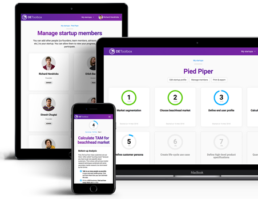Entrepreneurial Leadership—Vulnerability and the Importance of the Unquantifiable

My journey as an online learner in the MITx Entrepreneurship 101 course on edX marked for me the beginning of a progressive discovery of the power and importance of community. There is a deep joy that can be experienced through building inspired and respectful collaborations, based on reciprocity and the feeling of something being moved forward together. Although working with one another is sometimes terribly challenging and certainly always complex, it might ultimately be the only effective way to create tangible and truly meaningful impact in the world. Adam Kahane’s “Collaborating with the Enemy: How to Work with People You Don’t Agree with or Like or Trust” has been key in helping me to formulate my more recent framing of community building: it is an exercise in stretch collaboration.
Something about controlling outcomes has to be let go of, and something about surrendering to not-knowing needs to be embraced, as a pathway towards unprecedented and pregnant possibility.
During a Visual Practice Workshop that I joined in July 2018, I tried to dig deeper into the feelings that were at the roots of my motivation and energy around staying involved with the Alumni community. After some solo time in Nature, and a journaling exercise that were part of the workshop programme, some keywords that emerged for me — in no particular order — were: birth, enduring, step into, trust, outgrow.
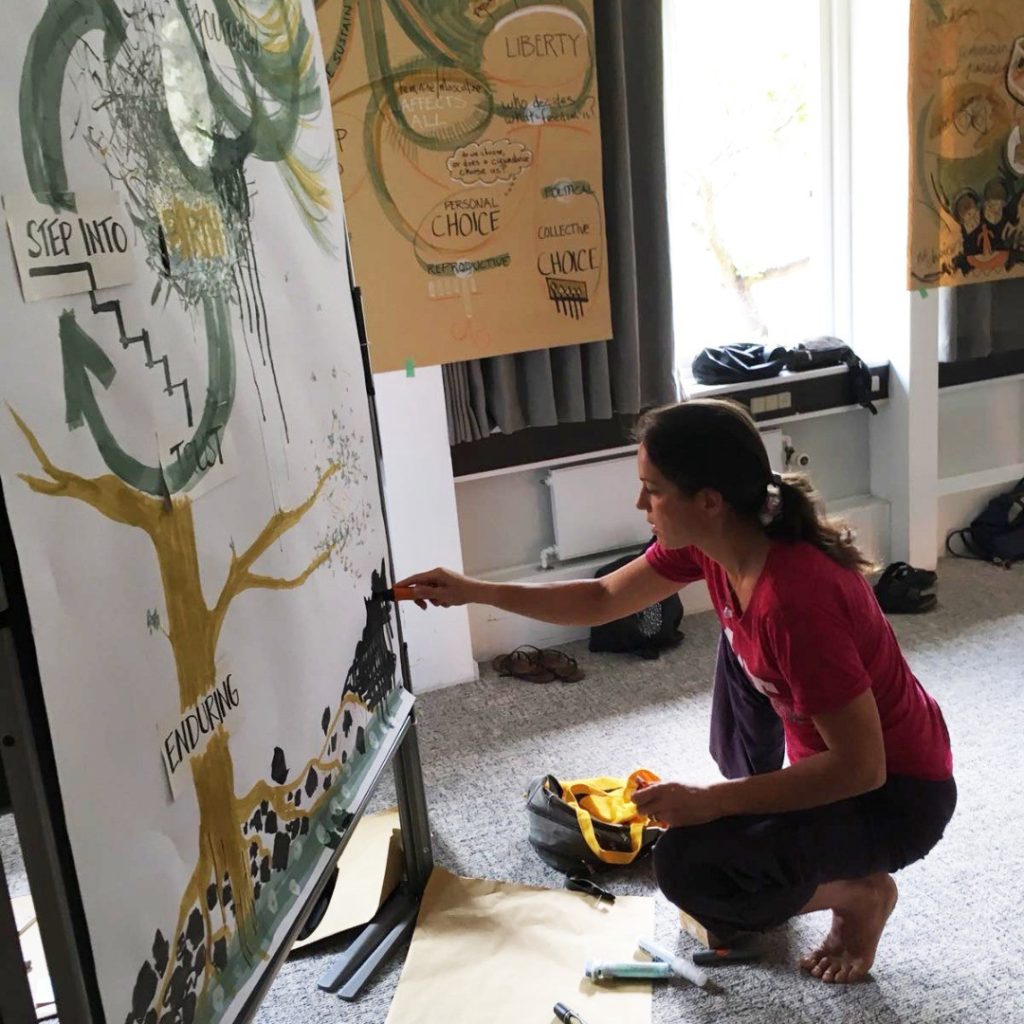
An emerging picture then began to form before me, through me, almost in spite of me — before I could even yet make sense of it. It gave me some clues regarding my inquiry into the essence and elements of leadership. There was:
- the quality of endurance (of being able to grow roots even in dry rocky terrain, pushing down deep enough to get to the rich underlying soil);
- the capacity to trust (oneself and others, sometimes despite an overall feeling of “not knowing” exactly);
- the courage to step into (that is, the capacity to show up and do whatever needs to be done, even if the space ahead looks like a void),
- in order to birth what it is that is wanting to be born (through my work, my energy and my capacities);
- and, finally, the culminating moment of outgrowing (in other words, the awareness of perhaps no longer being essential, or even needed, at all, and the grace and acceptance of being able to let go, with love.)
Here are some journaling notes pulled straight from my Ecosystem Leadership Program workbook:
WEEK 4 — Holding space
Deep listening is exhausting! How can I make it nurturing also for me, and not just others? Where is the boundary? And when is letting go even more impactful or useful than doing? Is excessive watchfulness and stewarding stifling the true manifestation that is wanting to emerge from the ecosystem? (15th May, 2019)
WEEK 5 — Accessing the open mind/heart/will.
As I lean into my crazy prototyping project with the community (a 24-hour online chat space dedicated to the 24 steps of Disciplined Entrepreneurship to take place on the 24th of May), I get stuck for a moment by one negative voice (or maybe it was just a questioning voice) that asked me “what is the intention behind this”? I suppose it just surfaces a question I carry within me, that does not have an articulated answer, except for the feeling that it is something that “wants to happen”. (22nd May, 2019)
The me/we — us/them tension is such a mystery. I have difficulty sometimes understanding the signals. What is the bigger ecosystem trying to manifest, and am I creating space for that to happen? For example, the 24-hour Zoom room idea came from Phil [edited name]. Everyone (including me) loved it, and I began to take action to make it happen, because I have the tools (and energy) for it (our networking platform, the connections with people, the community holding capacity, etc.) Then I started to feel too much load, so I asked Phil if he was still behind this initiative, how much he could put into it, and he replied “don’t worry, I am here to help and support you.” I thought to myself: “What? I am the one helping YOU!” I was very annoyed but I sat with the discomfort for a whole day. Then I began to understand that the “ownership” issue was a trap. What I needed to understand was something else: the real question here was, is this wanting to happen, and is there the energy for it? So it really does not matter, in the bigger picture, whether it’s “Phil helping Rachel” or “Rachel helping Phil” because that is beside the point. (22nd May, 2019)
The point of doubt is an interesting place to dwell. One cannot hurry through it, and trying to bypass it is a big mistake: it is the richest place of learning and insight — but it is also very lonely, and very uncomfortable. This is where the processes and community of practitioners from the ELP (Ecosystem Leaderhip Programme) fueled me with an incredible capacity to sit with — and through — the unease.
“And then, the surprising twist. That single, insinuating voice of doubt is overcome by the collective will that I feel emerging from beneath, even against my own spontaneous instinct of self-protection. In the very moment that my ego could let go completely of the performance angst connected to the prototype execution and its outcomes, something had already, in itself, been achieved, in the here and the now. And something was set in motion. There is community coalescing around just the trust, the courage, and the vunerability of not knowing exactly.” (ELP workbook journaling notes— 22nd May, 2019)
Ecosystem Leadership (ELP) Methods Applied
I wish to share the six steps of the Practice Research framework developed by the Presencing Institute team (and beautifully illustrated by my colleague, artist and generative scribe Kelvy Bird), that I was able to apply to our prototyping situation:
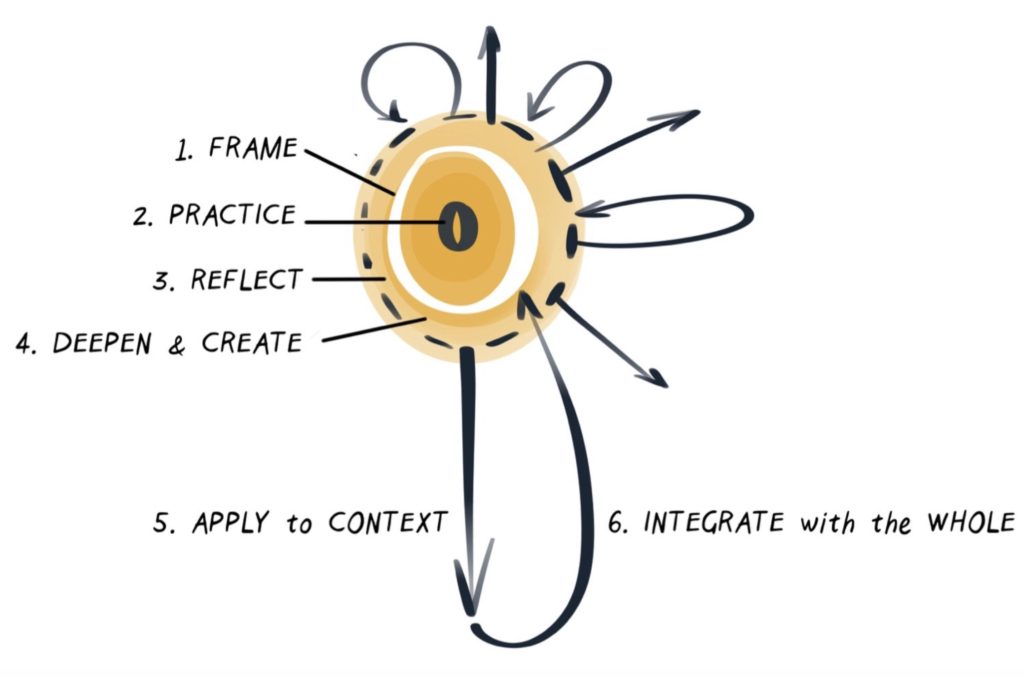
- Framing: defining the intention — our objective was to experiment what sort of initiative might serve to engage and nurture the community, creating value and meaning for everyone while remaining flexible and low-effort enough that people would readily make the time to engage.
- Practicing: experimenting our way forward through prototyping — we kept the action rolling quickly, without getting too attached to specific ideas or outcomes, to learn by doing.
- Reflecting: processing insights gained and noticing from things tried — it was very informative to see some parts fall through, and others gain momentum, beyond the desire to predict and control.
- Deepening & Creating: using social arts (generative scribing — as described earlier, embodiment — through Social Presencing Theater) and creative journaling , to deepen inquiry and insights.
Surrendering to the dialogue is difficult, and when it happens, there is a palpable shift. And that shift really sits physically in the body I feel, there is something that happens in the chest and in the heart, and in the in-between space that connects us to the other person (or the group/community).
(ELP workbook journaling notes — 22nd May, 2019)
- Applying to Context: implementing and applying new learnings in context — it was necessary to keep feedback loops swift and open and be ready to rethink assumptions, based on how each action was (or wasn’t) generating results.
- Integrating with the Whole: sharing with others in the ecosystem and beyond — we were very aware that anything we were able to create and harvest during the 24-hour event needed to make sense in a larger community context, to include also those who were not able to take part directly in the initiative. Taking this one step further, another question might be “how do we bring this body of work into the world, beyond the boundaries of this community, and what could that look like?”
Epilogue—Some Closing Thoughts
Wrestling with the notion of leadership, community and prototyping through the process of linking research, action and integration over the past four years has brought me some of the following learnings.
On leadership and vulnerability: trying to hold together in a predetermined framework a very diverse community of brilliant, entrepreneurial individuals is like trying to herd cats – theoretically and practically impossible. Holding space for that community, on the other hand, is a different way to approach and frame the question, and perhaps the only possible way to move forward: through flexibility and a genuinely co-creative stance.
On tenacity and patience: community fabric is woven slowly, painstakingly over time, and not an overnight phenomenon. Much of the time needs to be spent waiting, because patience and coherence are the only factors that can truly generate trust.
On overcoming the “empty room” syndrome: being “in service of” entails a great amount of invisible work, as well as risk-taking. It may well be that nobody turns up. You need to be make peace with your own worse case scenario, as a way to free up possibility, which is what — ultimately — will likely end up drawing people into the space. The voices of cynicism, doubt and fear need to be put to rest by recognising and acknowledging them in order to push past.
On self-awareness and mindfulness: making sure to factor in time and space for oneself is critical and too often overlooked, and a difficult trap to avoid. One of the breakthrough achievements for me during the 24-hour project was to keep space for myself, thereby leaving space for others to step up their game and take the helm.
On surrendering to the unknown:
letting go (of control, of predictions, of wishful thinking and of outcomes) is — I believe — the most powerful way to unlock infinite possibility. Surprise and gratitude are the reward.
I have had to let go of a desire to have a go-to, all-encompassing Alumni channel. I have “surrendered” to the fact the community wants use a combination of channels: Whatsapp, a variety of Facebook groups, Facebook Messenger, the Google suite of online collaboration tools, Zoom and Skype for video connection. People need to be met at the point where they are: while some behaviours can be shaped over time through modeling desired outcomes, it’s impossible to force people into new habits.
What, you may perhaps ask, is all of this ultimately worth? My personal answer to this question is: it’s priceless. It’s the grand prize of daring greatly, to partake of an unprecedented, emerging future. In final closing, here are some thoughts I had the privilege to share in a recent interview hosted by Mighty Networks: https://youtu.be/bUhfvPl5L0s
Footnote: this is the 5th of 5 articles adapted for the Disciplined Entrepreneurship website, from an original article by Rachel Hentsch, published on Medium.
The author
Rachel Hentsch
Rachel Hentsch is an MIT-Certified Teacher in New Ventures Leadership. She is passionate about strengthening global communities, using tech tools to connect dots. She heads communications at the Presencing Institute and has been researching and prototyping ways to keep global community members connected meaningfully.

The Disciplined Entrepreneurship Toolbox
Stay ahead by using the 24 steps together with your team, mentors, and investors.
The books
This methodology with 24 steps and 15 tactics was created at MIT to help you translate your technology or idea into innovative new products. The books were designed for first-time and repeat entrepreneurs so that they can build great ventures.
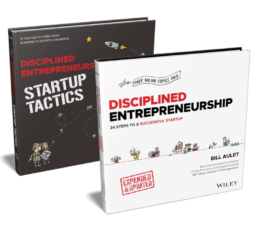
Lessons Learned—25 Hours and Beyond
Overall, the #24hours24steps event was a resounding success, both numerically speaking and in terms of “community temperature”. Here is a summary of the outcomes and the future ideas that came out of it for the MIT Bootcamp Alumni community.

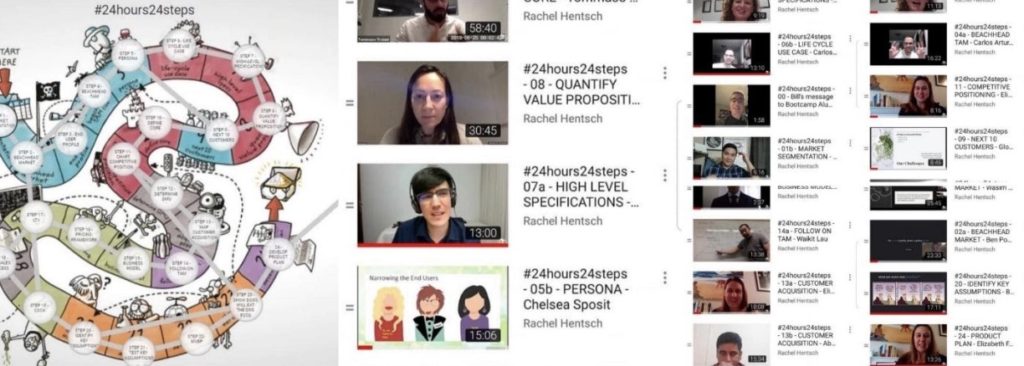
Numbers — the quantifiable
- Participation data: during the course of the 25 hours of the event, a total of 287 participants joined; the virtual Zoom room registered a low of 3 participants (at no time did the space remain empty) and a peak of 28; one Alumnus even stayed on uninterruptedly for the entire duration of the videothon;
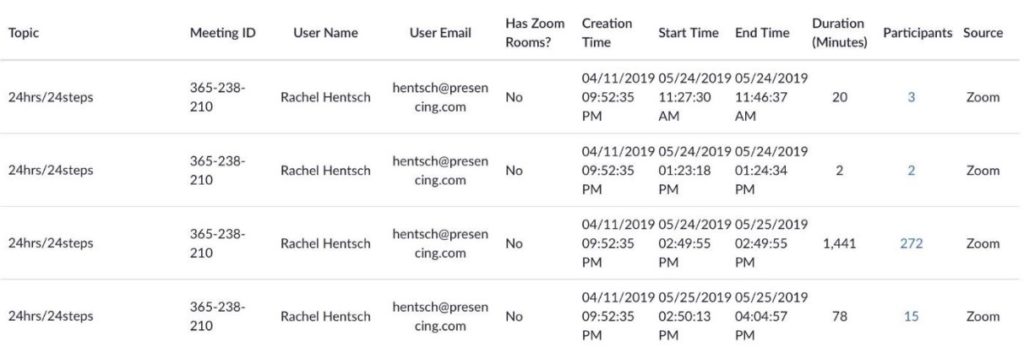
Participation data gleaned from Zoom - Harvested resources: a total of 25 hours of footage was recorded and edited in the ensuing weeks, resulting in a total of 65 video clips ranging from 10 to 60 minutes each, uploaded to a YouTube playlist and made available to the extended Alumni community through sharing one video per day; other written data is still being parsed for reshare; we believe this will form the basis for creating a case history archive that could be of benefit to our whole community, including entrepreneurship teachers and trainers.
- Ongoing conversations: a forum-like container space was added into our MBA² Alumni network platform, to house ongoing discussions around each of the 25 steps thus enabling an asynchronous cumulation of our collective intelligence over time.
- Creative inspiration: one Alumnus who is a graphic designer ideated and executed on his idea of mirroring back to the community a sense of what had been generated, as well as honouring the work of content contributors, by putting together a Speaker Map and Speaker Cards.
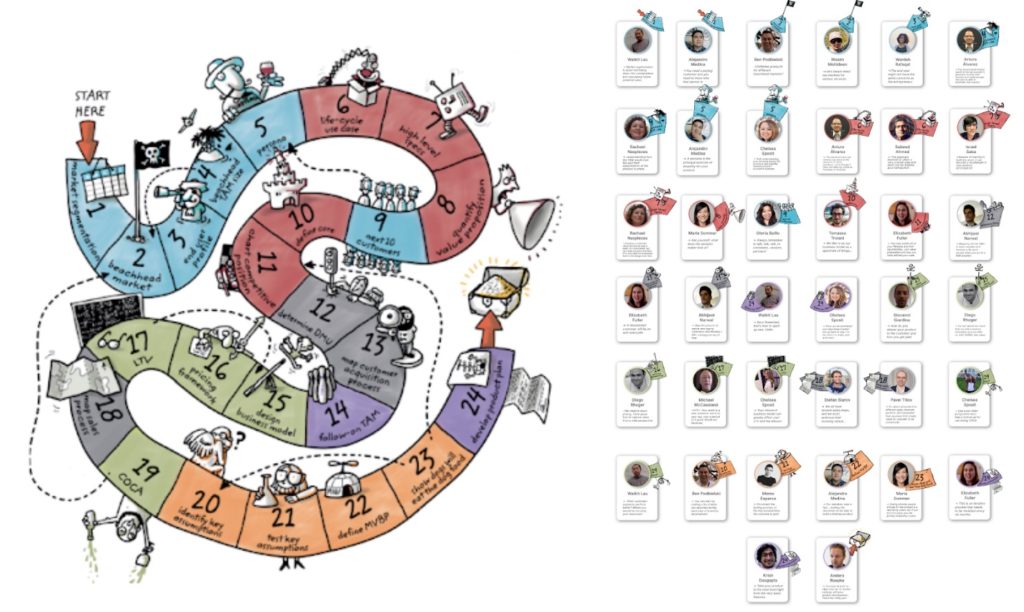
Speaker Map and cards by Bootcamper Alumnus Guillermo Esparza
Community Fever — the less-measurable
- Testimonies : Some of the less quantifiable, warm data, comes in the form of heart-warming testimonies, here is one example I quote from a participant who also committed to help facilitate a session: “A success! The energy level was so high that the adrenaline rush is still kicking in! From industry veterans to tech wizards to innovators to commendable spokespersons, each one of you added a wonderful angle to the story, and to the learning journey. Everyone played a vital part.”
- Imagination : Also, it is interesting to observe (in some of the more recent community interactions) the imaginary projection of this prototype into possible future evolutions — for instance, some Alumni are excited at the thought of a more structured “24 hours in 24 days event”, or forming peer-driven coaching groups, or even setting up outward-facing consulting clusters. It is as though new energy has seeped into the social soil like oxygen through the plough of this prototype, thus expanding the future field of possibilities and germinating a higher, more ambitious future potential for a community that is learning about its own capacity to create impact through harnessing the power of the pack.
- Collaborations : exciting new conversations and prospects are being born across the network as a result of having once again joined forces to work toward an exciting common goal.
In the context of my work with the Presencing Institute regarding leadership and communication, I am particularly interested in better understanding the relationship between leadership, vulnerability and trust. This is what we will look at in the last article of this series, where I share the reflections and observations that derived from the #24hours24steps initiative.
Footnote: this is the 4th of 5 articles adapted for the Disciplined Entrepreneurship website, from an original article by Rachel Hentsch, published on Medium.
The author
Rachel Hentsch
Rachel Hentsch is an MIT-Certified Teacher in New Ventures Leadership. She is passionate about strengthening global communities, using tech tools to connect dots. She heads communications at the Presencing Institute and has been researching and prototyping ways to keep global community members connected meaningfully.

The Disciplined Entrepreneurship Toolbox
Stay ahead by using the 24 steps together with your team, mentors, and investors.
The books
This methodology with 24 steps and 15 tactics was created at MIT to help you translate your technology or idea into innovative new products. The books were designed for first-time and repeat entrepreneurs so that they can build great ventures.

The Experiment – Tackling 24 Steps in 24 Hours

One of the most recent lessons in letting go and surrendering to what wants to happen in the community was the #24hours24steps prototype: an uninterrupted, 24-hour-long video meeting, designed to be open to all members of the MBA² community.
1. A Wildly Exciting Idea
The big crazy idea was born during one of our weekly online Alumni update calls, where some of us gathered to check in with each other and share ideas around what next initiative we could experiment with to keep the community alive and thriving. The idea that emerged (and which at first seemed too crazy to even contemplate) was this: to design an event that would connect all Alumni across all time zones, around what in fact is the underlying foundation of why we are a community; the 24 Steps of Disciplined Entrepreneurship — the subject of Bill Aulet’s book and teachings on entrepreneurship, which provided the framework of our body of learning, as well as a shared common language that we were all familiar with, and could understand each other by. For each of the twenty-four hours, the conversation would focus on one of the twenty-four steps, in ascending order from 1 to 24, and all Alumni would be invited to convene online to share questions, insights, and learnings about that one particular step.
2. High Energy… and then what?
The idea seemed to exude a certain undeniable appeal, and appeared to stick. It was thrown into the mix of the conversation almost casually, almost out of jest, but it immediately captured the imagination and fired up the enthusiasm of many: there was an aura of quirky grandeur that was undeniably captivating, possibly also to do with the numerical alignment – 24 hours, 24 steps (to which we then added a date: the 24th May – just to make it all fit together perfectly.) Also, endeavoring to hold space around the clock made great sense to a community so diverse and spread across the world as to cover all existing time zones: it was exciting to imagine participants being able to join at times that would be compatible with their individual schedules.
However, as we all knew from our MIT Bootcamp experience, an idea is worth little if it just stops at the idea: execution is key. That’s when the project seemed to hit a hurdle. A first poll that was put out in January to measure interest registered an average 90% of probable commitment to the initiative on the part of respondents – ranging from being active speakers or presenters, to helping facilitate sessions, to just listening in (and 10% of I “don’t know”s): but how was this manifestation of interest now going to be harnessed and translated into action? That was the million-dollar question.
3. Wrestling with the Voices of Doubt, Fear and Cynicism
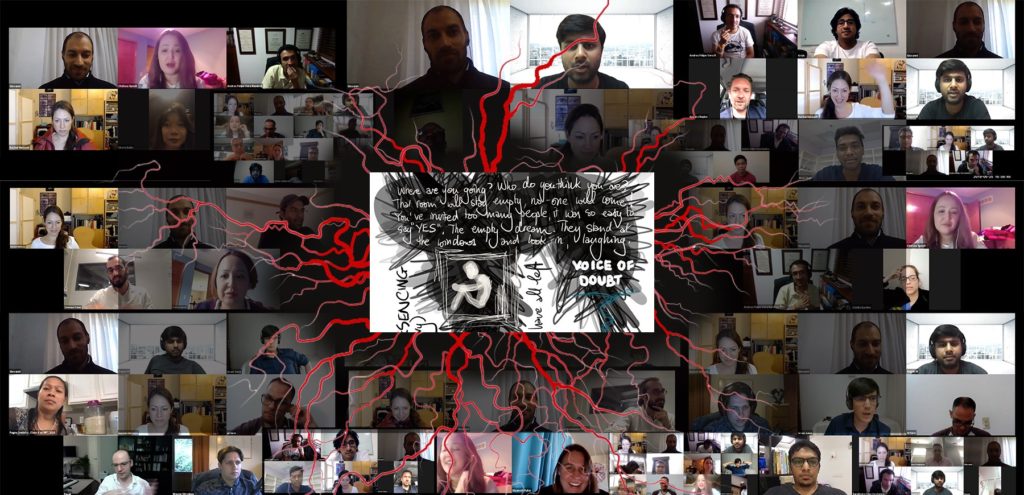
Doubt —Therefore, despite the seemingly enormous initial wave of momentum and enthusiasm, the initiative hit a bottleneck, and I found myself left with a sense of responsibility to serve and deliver, yet puzzling over what to do next. This happened right at a time when I was dangerously skirting burnout, and thus also trying to create personal boundaries for myself in terms of time and energy spend. Where — I wondered —was the sweet spot, at the intersection between busily doing and gracefully letting things happen?
Fear —This (very legitimate) question triggered my anxiety to a point where I suddenly found myself grappling with the “empty room syndrome”: what if, despite a declared and widespread interest to participate, the lack of a clear objective would ultimately result in a no-show situation, and the virtual discussion space remained empty?
My big challenge – after having acknowledged the intention to “surrender” – was then trying to feel into, and grasp, WHAT exactly needed to be surrendered:
- was it the prototype itself (i.e. “this is not wanting to happen Rachel, that’s why you are feeling heaviness and resistance”)?… or
- my expectation of what the project was “supposed to bring” (i.e. “this is wanting to happen Rachel, and you are looking for reasons to pull out.”)
Cynicism — On certain days the zeal for being in service of a cause can wane under the sheer load of holding space and egging others on tirelessly, and you start to ask yourself: “Well, actually, what’s in this for me?” When the only authentic, heartfelt answer is “it gives me joy”, some days that just doesn’t feel very bullet-proof.
5. Defining a «Mininum Acceptable Scenario»
The light at the end of the tunnel started to appear when we squarely faced what we imagined might be the worst case scenario: it was about facing the empty room, full on. I strongly wish to emphasise that this breakthrough moment would not have happened had I not deliberately decided to listen, with open mind, open heart and open will to every single voice that rose with something to say about the subject —however ponderous, critical or minimal.
a) Worst case scenario, what could that look like?
- Hypothesis 1 — only two Alumni showing up at a given hour: we agreed that where there are two MIT Bootcampers connecting, there will be a conversation, and there will be possibility and creation.
- Hypothesis 2 — only one Alumni shows up: the room is empty, he/she leaves and tries again later.
- Hypothesis 3 — no-one is there: what is lost? Nothing at all! (Apart from some time, some effort and perhaps some credibility and reputation.)
The surprising part of this was that to name the fear was to dispel it. I will say it again: “in the very moment that my ego could let go completely of the performance angst connected to the prototype execution and its outcomes, something had already, in itself, been achieved, in the here and the now. And something was set in motion.”
Things began to happen, as though energy had been unleashed and released — proactiveness, creativity and ownership blossomed:
- a 25th step was suggested by one Bootcamper and added to the programme (based on his direct personal startup experience of having applied all 24 steps and realising he wanted to add more to the framework — and share his insight with us);
- new speakers and hosts stepped up to the occasion, quickly filling residual gaps in the event timetable;
- video prerecords were wisely suggested (by someone with expertise in running live broadcasts) and we made a mad dash to get those prepared (and they were definitely a lifesaver);
- excitement in the community became once again palpable, people were already looking further and beyond, towards future initiatives and possibilities, and new community fabric was visibly being woven across cohorts (and Alumni who had never met or spoken before then) as our last online preparation meetings crystallised into new operational action points;
- last but not least, the participation of a couple of our top lecturers was requested — and secured.
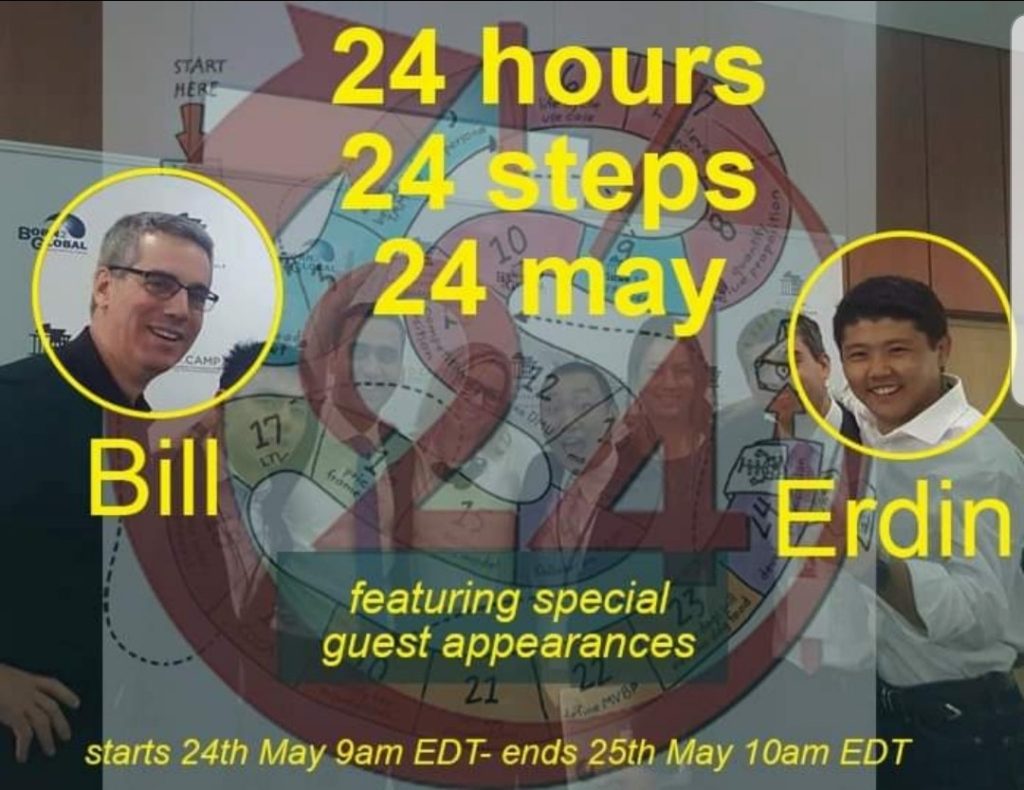
b) Pulling together a small team for collective holding and execution
Staying mindful of my personal boundaries of well-being required me to create a small team for the execution and micromanaging aspects of the project. This seemed to just happen quite naturally once I made my intention clear to my own self. In no time at all, we had a lean team of five, and clearly defined and distributed tasks that would afford me pockets of respite and rest.
The ensuing social/technological experiment was a very exciting first step in opening up a multitude of future possibilities. In the next article, we will look at the details of the project, the ensuing harvest, and the lessons learned.
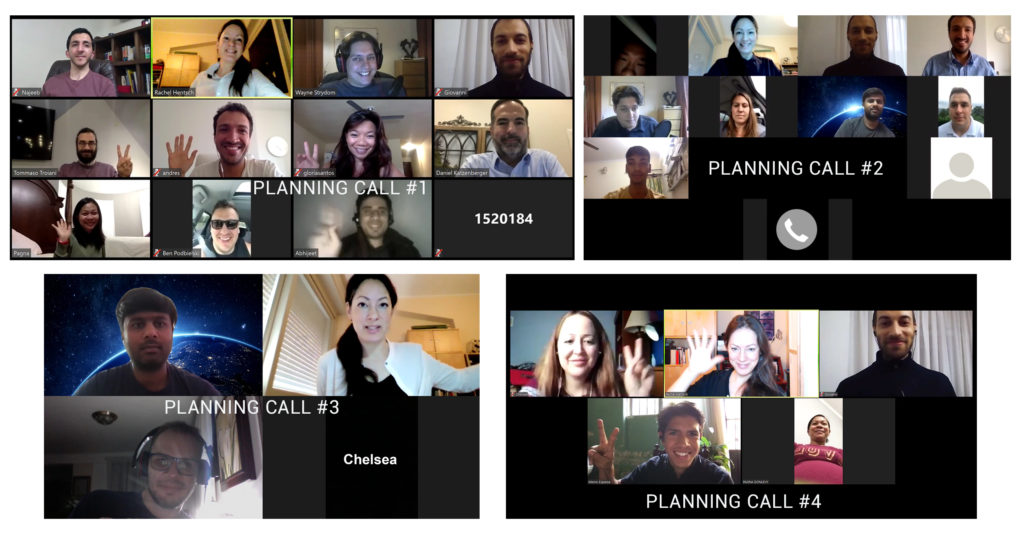
Footnote: this is the 3rd of 5 articles adapted for the Disciplined Entrepreneurship website, from an original article by Rachel Hentsch published on Medium.
The author
Rachel Hentsch
Rachel Hentsch is an MIT-Certified Teacher in New Ventures Leadership. She is passionate about strengthening global communities, using tech tools to connect dots. She heads communications at the Presencing Institute and has been researching and prototyping ways to keep global community members connected meaningfully.

The Disciplined Entrepreneurship Toolbox
Stay ahead by using the 24 steps together with your team, mentors, and investors.
The books
This methodology with 24 steps and 15 tactics was created at MIT to help you translate your technology or idea into innovative new products. The books were designed for first-time and repeat entrepreneurs so that they can build great ventures.

Finding the Tools – Creating Space for a Disciplined Dialogue

Since 17th April 2018, I am founder and host of the MIT Bootcamp Alumni Association (MBA²), a bespoke and private online network that holds space for the MITx Entrepreneurship Bootcamp Alumni: “An exclusive Mighty Network, built by MIT Bootcamp Alumni, for the MIT Bootcamp Alumni.” Its description reads:
“Our mission is to connect, support, encourage and learn from each other, so that we can each reach our highest potential through continuing to harness the “power of our pack”. We believe this can best be done through co-creation and a stretch-collaboration mindset. #OnwardsTogether!”
Curating the platform entails hours of on-the-side work, mostly late into the night — hours subtracted from sleep. There is no shortage of so-called thankless tasks. And there is no money to be made – at least, not for now. The energy, the joy and the ideas that come from the network are hard to quantify and convey: they are not measurable, they are a tapestry of experiences and feelings (what Nora Bateson calls warm data), perhaps best shared in a narrative. Many people, including fellow Alumni, have often asked me: “Why are you doing this?” and the only authentic answer I can come up with is: “I don’t know, I just feel that this needs to happen, and that I can help it to happen.”
The MBA² Ecosystem — as it is today
Mapping is by definition selective, subjective and reductive, but it has helped me gain clarity on how the MBA² (MIT Bootcamp Alumni Association) is showing up (at this given point in time), how many of us there are in the picture, how we may be relating to one another, and where we may possibly be headed, tomorrow, next year or over the course of the next decade.
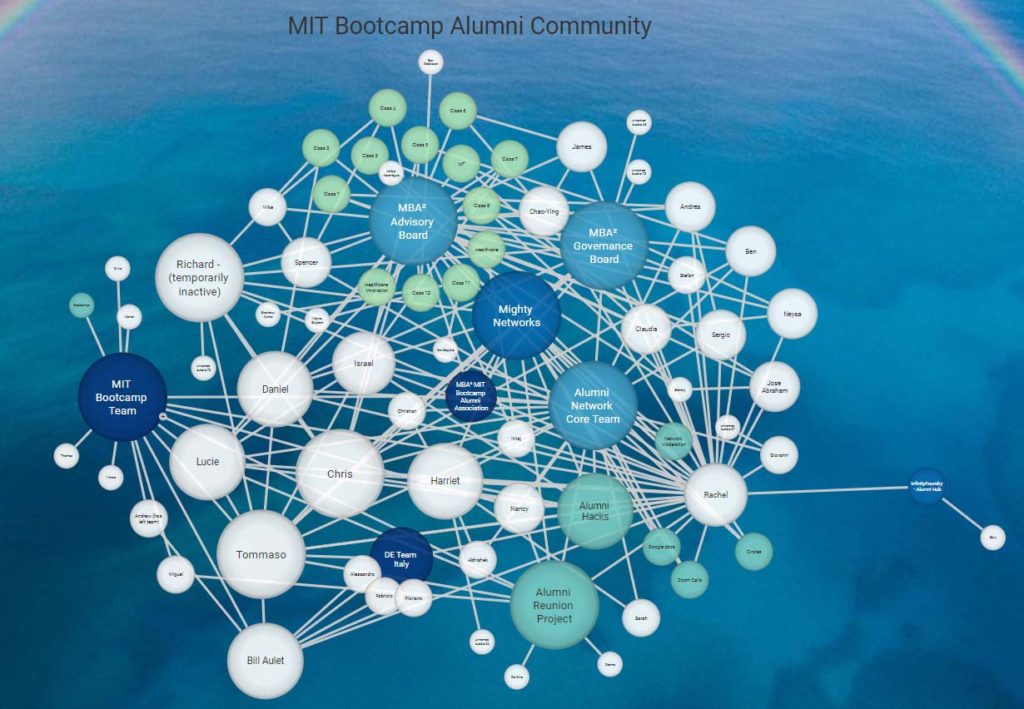
As I write, the MBA² network has grown over the last 16 months from a 5-person group (remotely brainstorming together in various online interstitial spaces), to what (in my previous article) I called a “reasonably sustainable model of space-holding”, that currently counts the following tangible elements:
- 610 members — who have voluntarily opted-in through invitation or word-of-mouth;
- 25 discussion circles — member-generated, for conducting topic-focussed group conversations, that range from particular subjects of interest (like Gamification, VC funding or Renewable Energy), to operational clusters (such as the core team, governance and advisory board groups), to place-based chapters (for instance the Brasilian Circle or the Brisbane-Based Bootcampers) to mission-inspired mastermind groups (like the Alumni Hack Circle or the Reunion Planning Group);
- 13 forum-like topics — for sharing news and information that is relevant to the community (see Image 2);
- 55 Alumni-centric events that have taken place (mostly all online) over the last year, at an average pace of one per week.

As I have recently shared in a dialogue on best practices with other community builders from the CMX Hub, one of the challenges posed by our community is the necessary looseness that has hitherto been needed to define and contain the boundaries of the network: because our community has to-date been completely voluntary-based and totally inclusive (it’s an Alumni community, where the only condition to join is to have partaken of one of the paid, in-person, MIT Bootcamp programs — the latter not run by us) the framework has forced us to stay very declaredly open and flexible, conceptually and operationally: in order for the community to survive in terms of entry, participation and engagement, it has had to be an open, welcoming space with no strings attached, therefore characterised by:
- minimum amount of rules;
- pressure to participate kept low;
- anything that gets created is considered a bonus by definition, and welcomed with gratitude and appreciation.
As a network founder and host, the lesson learned over time is to go by the principles of focusing more on what might be the overall, systemic intention of the community — above and beyond any individually limited personal vision of what should (or should not) happen. That’s what — in my work alongside Otto Scharmer and team at the Presencing Institute — we refer to as “what is wanting to be born” and “leading from the emerging future”.
In the next article, we will have a look at how the “24 Steps in 24 Hours” is a poignant illustration of how a project was born out of a shared community intention, struggled to see the light, and was finally brought to successful completion through harnessing collective capacity and energy.
Note: this is the 2nd of 5 articles adapted for the Disciplined Entrepreneurship website, from an original article by Rachel Hentsch, published on Medium.
The author
Rachel Hentsch
Rachel Hentsch is an MIT-Certified Teacher in New Ventures Leadership. She is passionate about strengthening global communities, using tech tools to connect dots. She heads communications at the Presencing Institute and has been researching and prototyping ways to keep global community members connected meaningfully.

The Disciplined Entrepreneurship Toolbox
Stay ahead by using the 24 steps together with your team, mentors, and investors.
The books
This methodology with 24 steps and 15 tactics was created at MIT to help you translate your technology or idea into innovative new products. The books were designed for first-time and repeat entrepreneurs so that they can build great ventures.

The MIT Global Entrepreneurship Bootcamp—A Desire for Community
It probably all begins with a desire to do more, be more, and connect with something bigger: that’s the common denominator that starts to connect those who enroll in the MITx Entrepreneurship courses on edX. These MOOCs (Massive Open Online Courses) are centered around Bill Aulet’s global bestseller ‘Disciplined Entrepreneurship’ and made available to prospective students worldwide through the open-source, non-profit platform known as edX.
Taking this to the next level: for those students who decide they might fancy crowning their learning journey with a hands-on, full-immersion, larger-than-life experience in entrepreneurial intensity, MIT offers the very selective MIT Global Entrepreneurship Bootcamp. This consists in a six-day stint that defies all laws of time and space restriction, where participants leave behind their notions of physical and mental limitation and learn to work in teams to build a new venture from scratch, from the business plan up until the final pitch on Demo Day in front of a panel of Investors and Business Angels. Access to this Bootcamp is extremely exclusive (when I applied in 2016, over 200,000 candidates enrolled in the MOOCs, 760 applied to Bootcamp, and only 73 candidates were selected to attend.)
The blast of knowledge and depth of friendships formed within a week are just two of the magnetic qualities of MIT’s Global Entrepreneurship Bootcamp. ‘Drinking from the MIT firehose’ barely touches the sides in describing it. Blend the cultural richness of the participants (over 36 countries of origin, ages ranging from 17 to 55 years, from all sorts of educational backgrounds and walks of life) with the caliber of the speakers and mentors and the result is a life-changing, unforgettable week.
Bootcampers learn from world-class MIT Senior Lecturers, who personify the MIT motto “Mens et Manus” (translates from the Latin to “Mind and Hand”) by being first and foremost doers, before they are teachers: an array of legendary entrepreneurs who share priceless tips and insights not only about the business side, but perhaps more importantly, about their very human and courageous attitudes to challenge and adversity.
The Bootcamp experience fosters grit. The explosive combination of circumstance, fatigue, and tension pits its participants against one another in an extreme test of endurance, resilience, and character. Bootcamp gradually and literally takes the individual apart, to a point that almost seems of no return. And then each student is reborn from a hopeless, desperate and delirious bundle of raw nerves, to suddenly blossom into their new potential. The breathtaking flow of teamwork perfection on the last day is a truly sensational and mind-boggling experience.
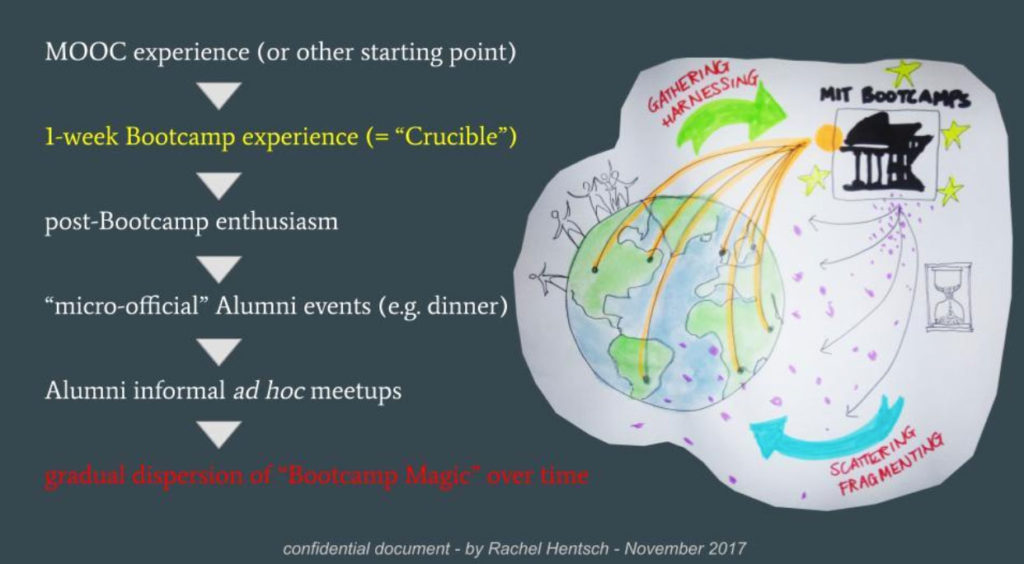
Bootcampers are left with a desire for something more, a continued and ongoing connection with their new “family”. The Bootcamp Alumni community is currently growing at the rate of several hundreds of new graduates per year. Bootcampers typically reach out to each other to meet up during their travels, or to ask for shared intelligence, even across cohorts. The Bootcamp experience as a common background is truly a glue that has the potential to hold the community together.
However, the flip side of the coin is that over time some factors are also slowly but inevitably undermining the community fabric: fragmentation, and the gravitational pull back towards “normal life”. As I perceive it, and from the research I have been conducting since 2016, the escalating pain points experienced by Bootcamp Alumni over time include: disconnect from the pack and from the Bootcamp team, disconnect between cohorts, loss of the sense of the whole (and therefore, of the tangible sense of belonging), a fragmentation of communications (see Image 2), and lost opportunities to connect, collaborate, share, listen, ask/get, provide coordinated support for each other, meet up, and create successful group events.
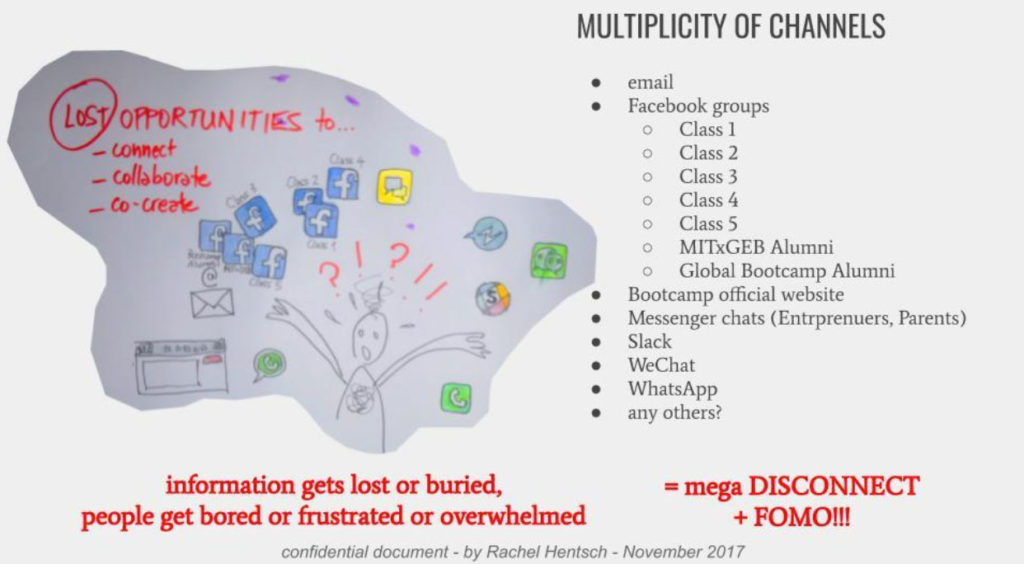
The stories we hear from each other every day continue to inspire us, and sharing them has a multiplier effect in terms of inspiration, motivation, and community awareness. Paving our entrepreneurial course in life can be lonely, and as humans, we are hard-wired to need a supportive ecosystem. Community presence and support are heartwarming in the deepest sense, and incredibly powerful. There is a need to keep reaching across to the farthest parts of the globe: our geographical and cultural diversity is both our strength and our greatest challenge.
It is fair to say that for every Bootcamp that has taken place, a handful of passionate Alumni have attempted to find solutions to keep the community alive and connected. There is no shortage of past experiments, that have each provided single valuable clues for the overall collective intelligence system: from Facebook groups to Messenger group chats, newsletters, prototype platforms, surveys, forums, spreadsheets, and maps. Images 3-7 below show some of the prototypes that I designed and tested during my action research period spanning 2016-2017.
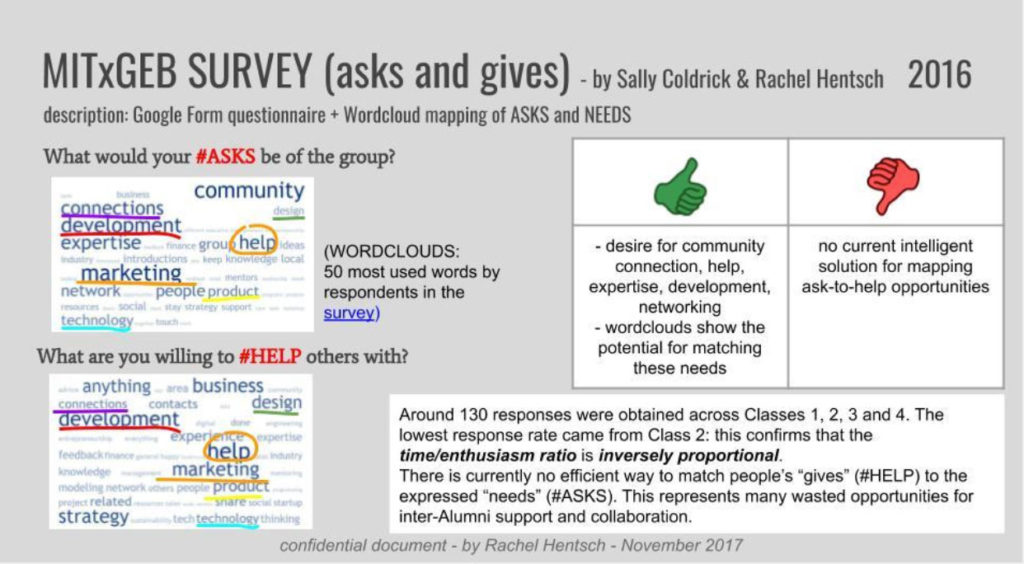
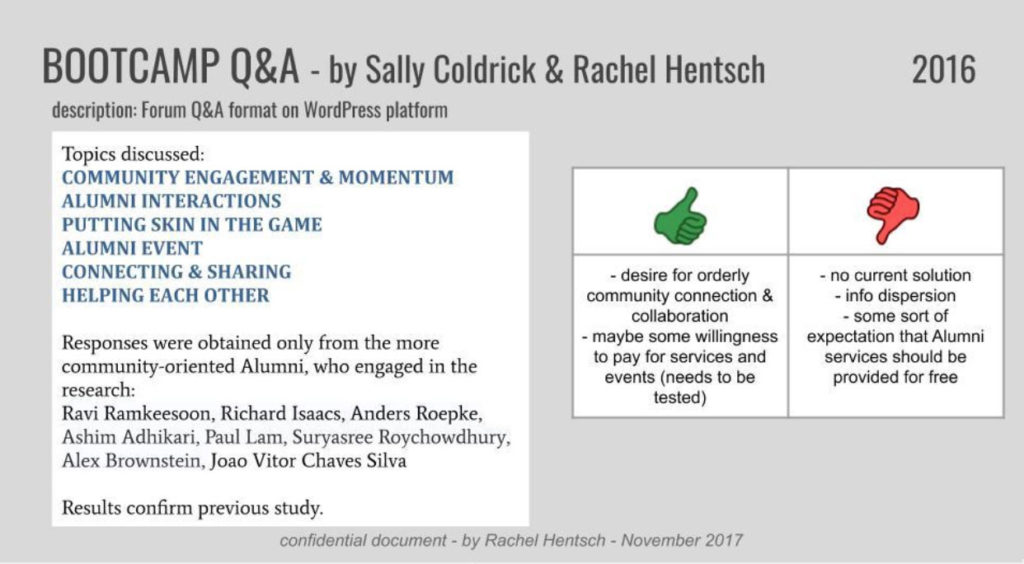
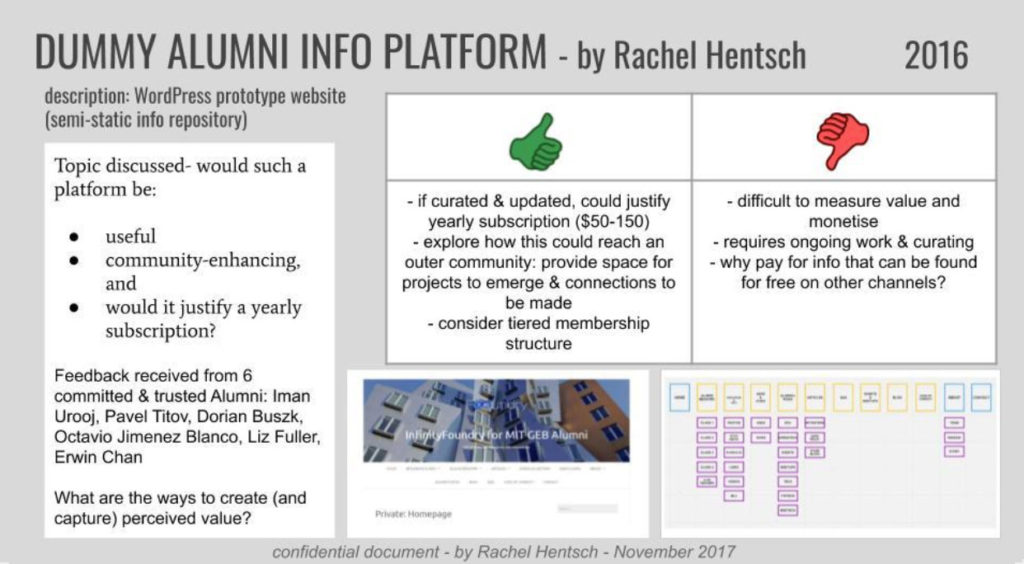
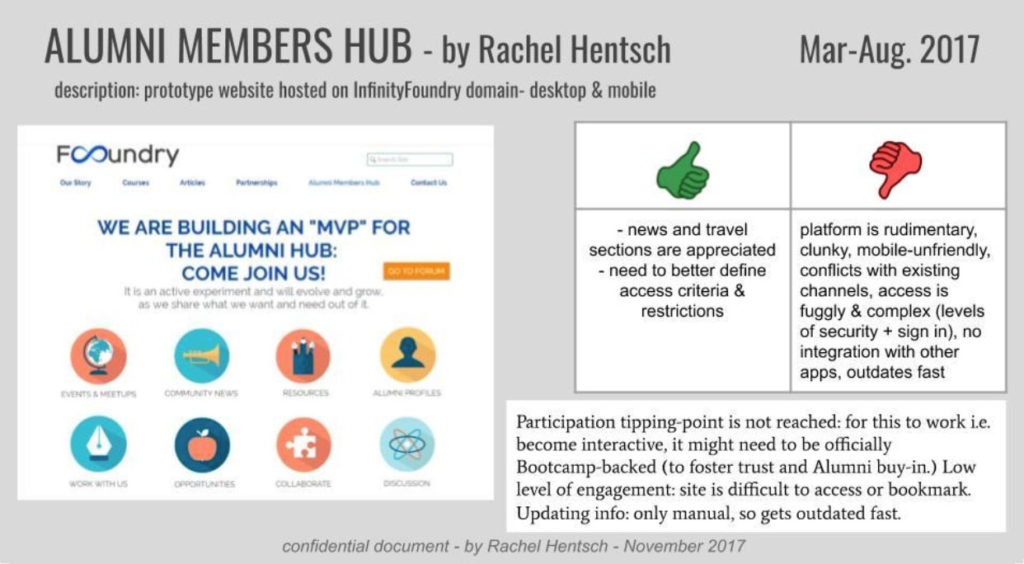
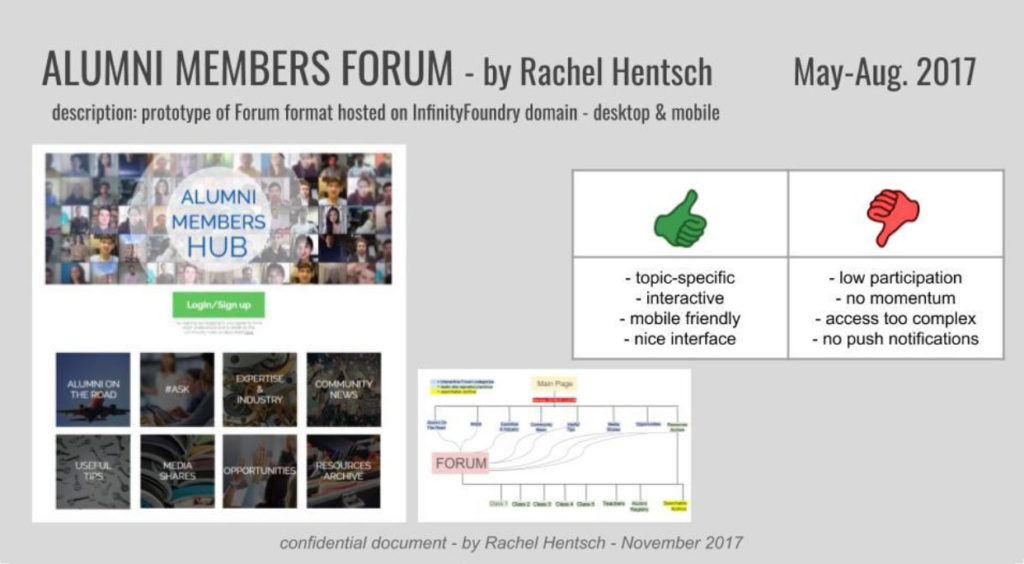
All of the above failed but were valuable lessons learned in understanding what worked and what didn’t. This has led up to what we have today, which is still far from being a complete and all-encompassing solution, but which can be seen as a “reasonably sustainable model of space-holding” for disciplined community dialogue. In the next article, we will look at the tools and platform we have built for ourselves to create and hold space for continuing to connect and build together.
This is the 1st of 5 articles adapted for the Disciplined Entrepreneurship website, from an original article published recently by Rachel Hentsch on Medium, also with extracts from articles on Bootcamp co-authored in 2016 by Rachel Hentsch and Sally Coldrick.
The author
Rachel Hentsch
Rachel Hentsch is an MIT-Certified Teacher in New Ventures Leadership. She is passionate about strengthening global communities, using tech tools to connect dots. She heads communications at the Presencing Institute and has been researching and prototyping ways to keep global community members connected meaningfully.

The Disciplined Entrepreneurship Toolbox
Stay ahead by using the 24 steps together with your team, mentors, and investors.
The books
This methodology with 24 steps and 15 tactics was created at MIT to help you translate your technology or idea into innovative new products. The books were designed for first-time and repeat entrepreneurs so that they can build great ventures.

